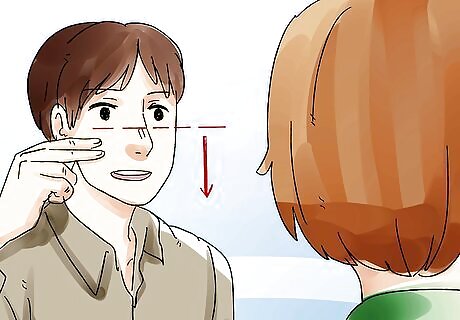
views
Doing Eye Focusing Exercises

Try to maintain eye contact for long periods of time without blinking. Look at yourself in a mirror and time how long you can maintain eye contact without blinking. You can also have a staring contest with someone else to test your ability. Having full command over your eye movements will help you maintain steady eye contact with the other person during the hypnosis.

Practice your ability to focus with your eyes. Do this by looking at a close object, like a pen or pencil and then a distant object in the room. Hold the pencil close to your face. Focus on the pencil. Move from focusing on the pencil to an object that is further away, like a picture on the wall or a doorknob. Return to focusing on the pencil. Then focus on the distant object. Continue practicing this to improve your focus flexibility.

Improve your peripheral awareness. This is your ability to see objects and movements on either side of you without having to turn your head. To improve this ability: Sit in a busy scene outside on a sidewalk. Or sit in front of a TV or computer screen that is playing a busy scene. Try to look at the busy scene with your head turned to one side. Then, look at the scene with your head turned to other other side. Try to see as much of the scene as possible on either side. Make sure you practice from the left and from the right.
Hypnotizing With Your Eyes

Ask the person for permission. Do this by asking them: “Can I hypnotize you?” Make sure they say “yes”. It’s best to practice hypnotizing with your eyes on a friend or loved one who trusts you, as they will be more willing to be hypnotized. It’s essential that the person be a willing participant. If they resist or don’t want to be hypnotized, the hypnosis likely will not work.

Have the person sit in a comfortable, upright position. Don’t have them stand, as they will likely become so relaxed during the hypnosis they will fall over if they are standing.

Tell the person to focus on a spot underneath your right eye. Instruct them not to look away as you speak to them.

Stare at them without blinking. Start counting from five to one in a soothing, low voice. As you count, tell them: “Your eyelids are becoming heavier and heavier.” “Your eyelids are growing heavy, as if heavy weights are pulling them down.” “Soon, your eyelids will be so heavy they will close.” “The more you try to open your eyes, the more heavy, loose, limp they become and the more stuck shut they will be.” Repeat these phrases several times as you count from five to one.

Tell the person you are going to touch their shoulder and then they are going to go limp. It’s important to tell the person what is going to happen before you touch them. This will set their mind up to understand you are going to give them a command and they are going to respond by doing what you tell them to do. Tell the person: “When I touch your shoulder, you are going to become loose, limp, and heavy. Ready?”

Touch the person’s shoulder and tell them it’s time to be loose and relax. Don’t be alarmed if the person slumps over or leans back in the chair. This is a sign they are completely relaxed and they are now under hypnosis.

Assure the person they are now under hypnosis. It’s important that the person realizes the relaxing state they are experiencing is due to hypnosis or being in a hypnotic state. Its also important to assure the person they are safe and they are in good hands. Reassure them so they continue to trust you and to listen to your commands.

Tell the person that their right arm should now be loose and heavy. Inform them it should feel limp and relaxed. Then, touch their arm to trigger a response from them. Lift up their arm to confirm it is now limp and relaxed. Place their arm back down. This confirms the person is now in a trance like state. It also shows they are willing to listen to your voice and your commands.

Set them up to follow only your voice. Count down from five to one. Tell them that when you reach “one”, they will only listen to the sound of your voice. Snap your fingers at “one” to focus them on your voice. Tell them to let your voice relax them even deeper. Then, instruct them to hear every word you say and only hear every word you say. Instruct them to follow only your words exactly, and no other sounds around them.

Test out their hypnotic state. Now that you have hypnotic control over the person, you can test out your ability by having the person touch their nose or their ear. You can also tell them to move their arms or legs on command. Keep in mind hypnotic control must be used responsibly and carefully. The person has put their trust in you, so do not abuse it by embarrassing them or hurting them while they are under hypnosis.
Understanding Hypnosis

Don’t confuse hypnosis with being asleep or unconscious. Hypnosis is actually a deeply focused state of mind that makes you more aware of suggestion and more receptive to those suggestions. It’s important to remember a person under hypnosis will not lose control or be under the hypnotist's spell. Instead, the person will be more open to suggestion and guidance. Often, we are under some form of hypnosis or trance. Think of when you zoned out during class, or got lost in a daydream. Or when you got so wrapped up in a movie or TV show, you lose your awareness of the people around you. These are all instances of being in a trance-like state.

Be aware of the benefits of hypnosis. Hypnosis isn’t just a fun party trick or a way to get your best friend to do the chicken dance. In fact, hypnosis has been shown to help individuals overcome insomnia, smoking, overeating, and other disorders.

Keep in mind hypnosis is a trained skill like any other. There is currently no state regulation of hypnosis. But hypnotherapists can become certified in basic or advanced coursework in hypnosis and hypnotherapy. However, it is a self-regulating profession. The certification course covers issues like professional ethics and basic hypnosis skills. Seek out a certified hypnotherapist for more information on the health benefits of hypnosis.




















Comments
0 comment